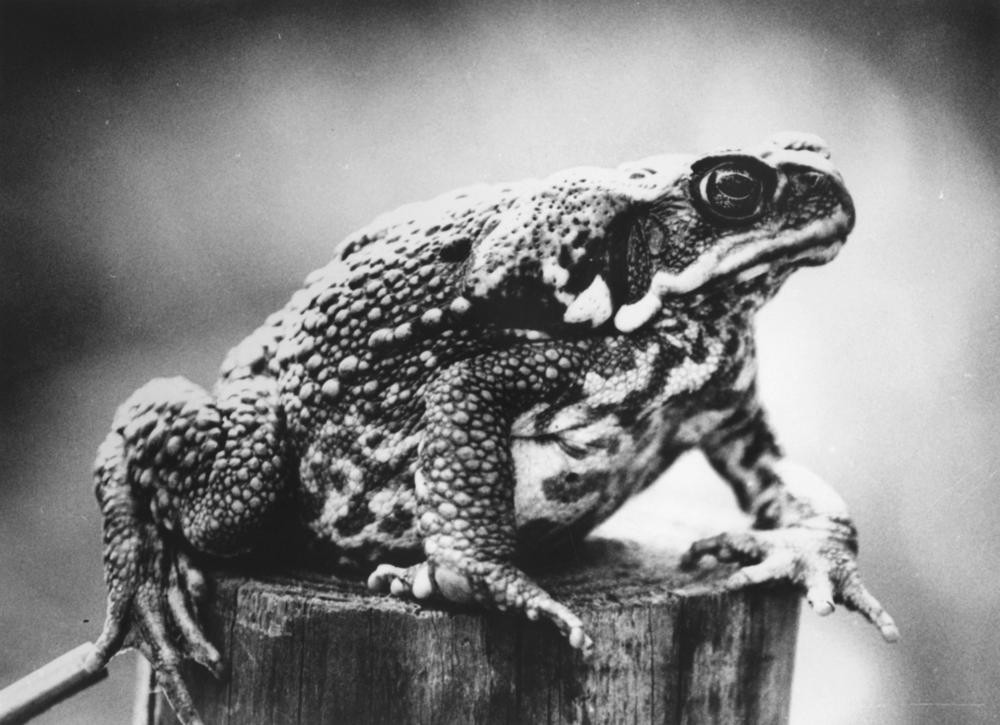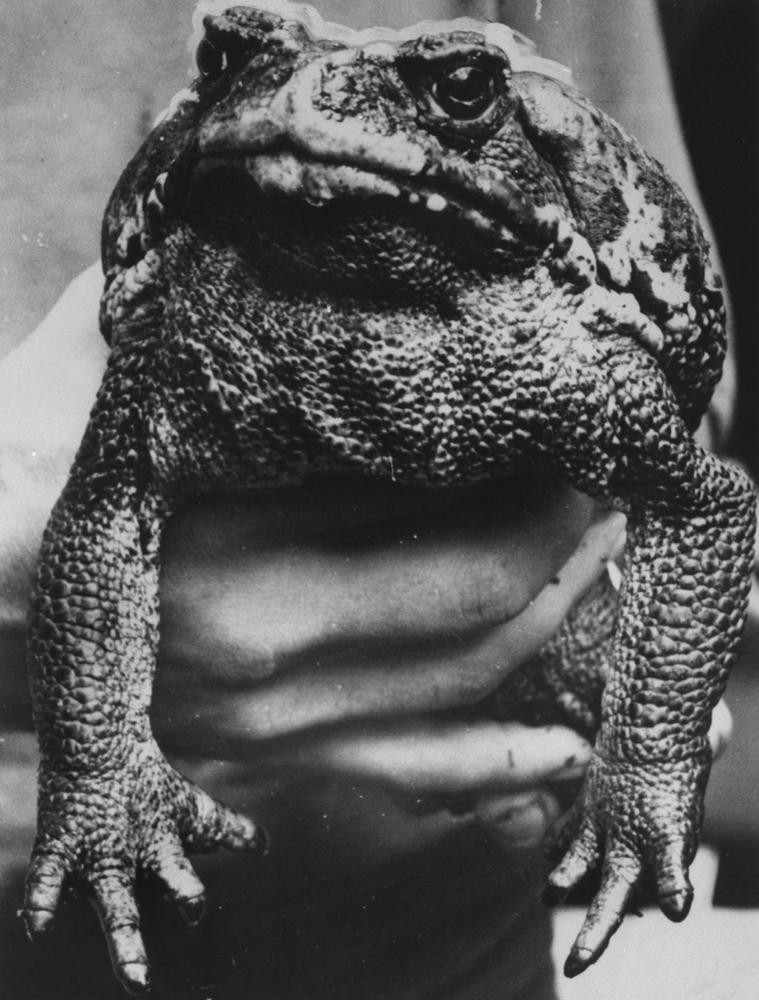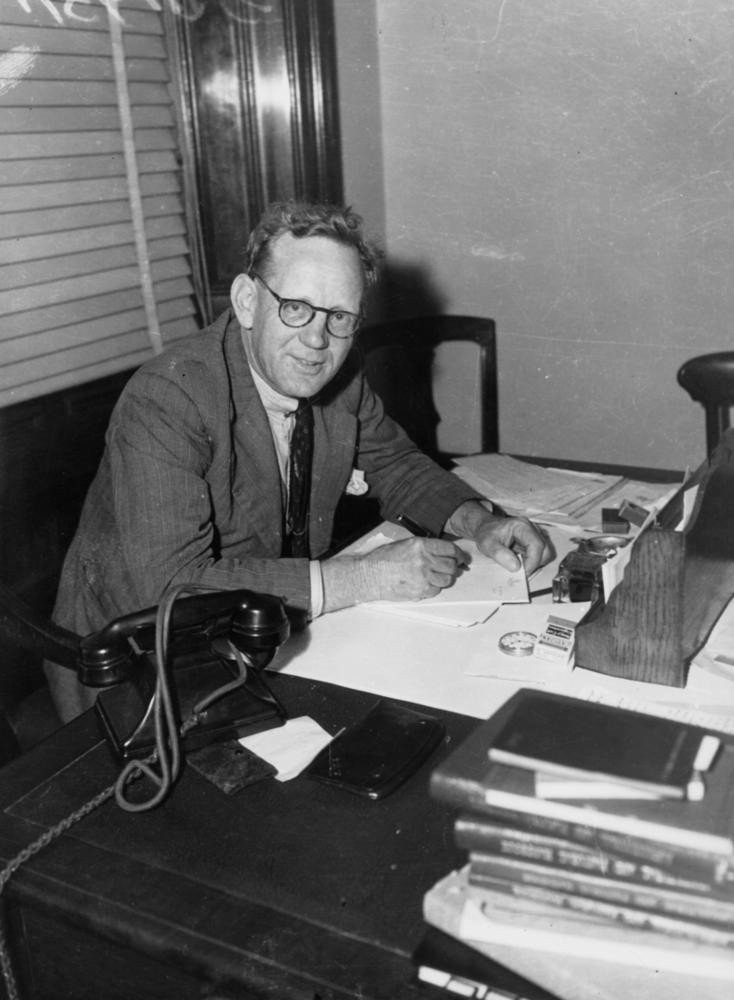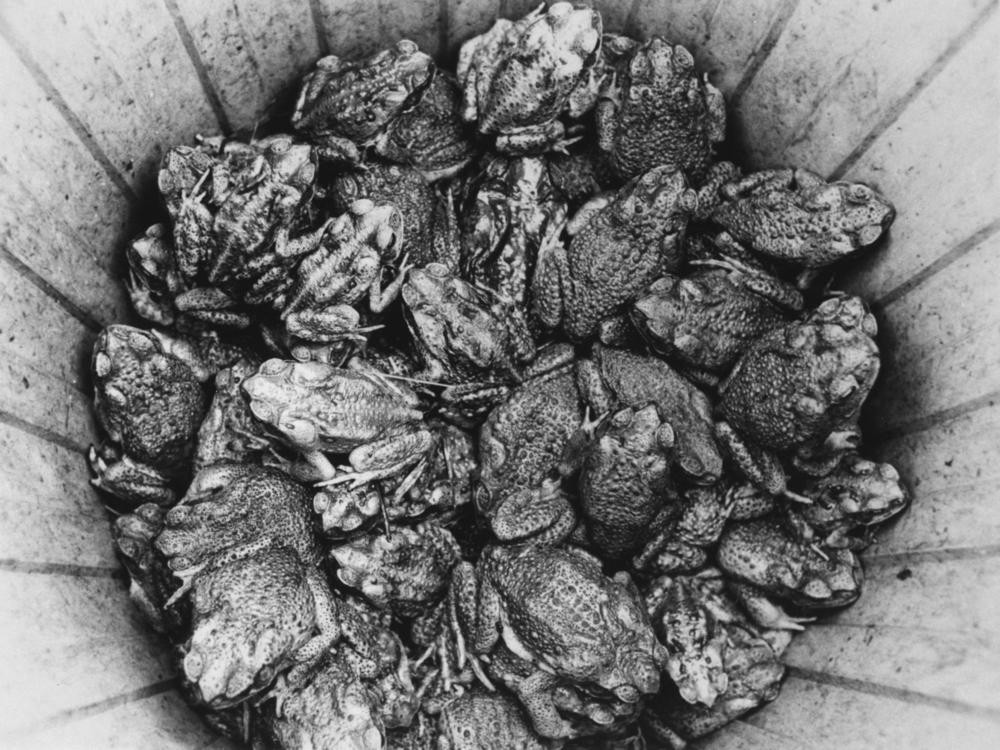TOAD ARMY LANDS : the cane toad in the press
By Simon Miller, Library Technician, State Library of Queensland | 7 December 2012
TOAD ARMY LANDS
American Foes of Cane Beetles
A new war is about to be waged in the canefields of the North. This time it is not the rat, but the grey-back cane beetle that is to be the subject of the offensive, which will be carried out by giant American toads. The first contingent arrived from Honolulu this week. The toads — 100 of them — reached Brisbane, in charge of Mr. R. W. Mungomery, assistant entomologist of the Bureau of Sugar Experiment Stations, Department of Agriculture, who left last night with his charges for the entomological laboratory at Meringa. This is the first time such an agency has been used to cope with insect pests in the cane fields, and more than one pair of interested eyes watched when the case in which the toads had made their long journey was opened at the department yesterday. They were big, brownish fellows—the largest of them from 6in. to 8 in.long — and they were as fresh as toads can be, although they had made the voyage packed together in a box with woodwool for padding. They did not require food on the way, and not one of them was lost in transhipment.

This is how the Courier-Mail announced the arrival of Queensland's first cane toads on 21 June, 1935. Since then the reputation of the cane toad in Queensland has suffered and they would be hard pressed to find a champion to argue in their favour. In 1935 cane farmers had high hopes that the toads would rescue them from the beetle grubs that were devastating their crops but even as the toads arrived doubts were raised about how effective they would be. An article from the Rockhamton Morning Bulletin is generally hopeful but also raises doubts.
The present introduction to Queensland is made in the hope that it may prove an important factor in the control of the white grubs which inflict such costly damage in the cane fields. It is to be understood that the toad deals with the insect in the beetle stage.
The Puerto Rico beetle, in the period between its emergence from the soil and its return for oviposting is said to spend the night in feeding trees or plants and to return to the soil early each morning. The toads are thus able to deal with the beetles as they leave or return to the soil.
The habits of the Queensland grey-back beetles are somewhat different, inasmuch as between the time of primary emergence and their return for oviposting - a period of about 14 days the beetles ordinarily spend their time between the feeding and resting trees, and do not make a regular return to the ground.
The success of the toad against the greyback. therefore, appears likely to be controlled by the length of time during which the beetle is on the ground and accessible to the toad - a matter which can only he determined by further observation when the toad has established itself in numbers.
They conclude by wondering if the toads might become a pest themselves.
The introduction of any new form of life naturally raises the question as to whether it is likely to become a pest. Careful consideration has been given to this aspect, and no reason can be found to assume that Bufo will be found in any way an undesirable immigrant. He at least comes with irreproachable credentials. It is to be hoped that he will be found an effective worker.
The cane toad, or giant American toad (Bufo marinus) is a native of Central and South America. Cane toads were introduced into the Caribbean to control pests from the 1840s but it seems to have been the enthusiasm of Dr Cyril E Pemberton of Hawaii that led to the export of toads more widely around the world. Dr Pemberton came across the toads while attending the International Congress of Sugar Cane Technologists in Puerto Rico in 1932 and promptly collected 154 specimens which he had shipped back to Hawaii. Also attending the conference in Puerto Rico was Arthur Bell from the Bureau of Sugar Experiment Stations in Queensland.

A report in The Queenslander of the the annual Queensland cane growers conference gives an indication of the enthusiasm of Queensland's sugar scientists for the toads.
Different methods of dealing with cane pests were considered by the conference, and a form of biological control quite new to Queensland was discussed. When Mr. Arthur Bell, of the Bureau of Sugar Experiment Stations, was on an official visit to Porto Rico some little time ago the employment of giant toads in pest destruction was brought under his notice, and he reported favourably on their usefulness in the cane fields. It is claimed for the giant toad—or Bufo marinus, to give it its scientific name—that it would prove very effective against the grey-back beetle, North Queensland's most serious cane field pest. It would probably be useful, also, in keeping down cane weevils, army worms, and mole crickets—insects that do a lot of damage to cane in the course of a season. The genus bufo will stand wide differences of climate, for it is found from Mexico to Argentina, living in localities varying in altitude from sea level to 6000 ft. It has proved very adaptable to a changed environment in tropical countries into which it has been introduced. In Porto Rico, for instance, it is recognised as a valuable factor in the control of the "white grub." It is believed that the toad would thrive in North Queensland. It is a night feeder, so the risk of its destroying beneficial in-sects of the cane fields, which are mostly about in daylight, would be very slight. ...
It is proposed to introduce a colony of toads and attempt to breed them at the experiment station at Meringa, and to liberate the first generation in the surrounding grub-infested areas. Failing to induce them to breed in captivity, their liberation in a suitable locality near Meringa is proposed. The proposal to introduce the giant toad into Queensland is, therefore, regarded as worthy of serious consideration, particularly as there is no evidence to show that its presence here would prove harmful in any way.
Not everyone was convinced that importing the toads was a good idea and entomologist Walter Froggatt was so alarmed that he lobbied the Commonwealth Department of Health to ban further releases arguing in a paper that ‘This great toad, immune from enemies, omnivorous in its habits, and breeding all the year round, may become as great a pest as the rabbit or cactus’.
The federal health department imposed a ban on the release of more toads which was promptly protested by Queensland's cane growers as reported in The Sydney Morning Herald, 29 November, 1935.
Canegrowers' organisations throughout Queensland protest against the declaration of the federal Director-General of Health (Dr. Cumpston) that no more giant toads are to be liberated on the northern canefields.
The announcement surprised canegrowers, as much time and money have been spent in investigating the habits of the giant toads, which are considered likely to be effective in combating canefleld pests. The Federal authorities made no objection to their introduction to Queensland from Hawaii. Already thousands of young toads have been liberated in the Gordonvale and Innisfail districts.
The outcome of representations of the Minister for Agriculture to the Federal Government is being awaited with interest.
Queensland agriculture minister Frank Bulcock and Premier William Forgan Smith pressured the Commonwealth Government and Prime Minister Joseph Lyons overturned the ban a few months later. Frank Bulcock was a strong defender of the cane toad as in this article from The Queenslander of January 26, 1938.
"Giant Toad Not A Menace."—From careful inquiries made before the introduction of giant toads into Northern canefields there was nothing to suggest that they would ever become a potential danger to human life, said the Minister for Agriculture (Mr. Bulcock). Mr. Bulcock ridiculed a recent report from North Queensland that a greyhound had been attacked and poisoned by a toad, and that residents were afraid of them, particularly as they were being attracted by lights to places of habitation. He was satisfied they were doing excellent work in the destruction of canefield insects, for which purpose they were imported. The giant toad, he said, was imported into Hawaii from South America, and its habits had been closely observed in both countries. One of the department's own officers was sent overseas to study it, and his inquiries did not reveal any objectionable features.

Objections to the toads came from several quarters. Beekeepers had been worried from the outset but government scientists continued to dispute claims of problems. This report is from the Courier-Mail of February 5, 1947.
Agriculture Department officials were sceptical yesterday whether the Bufo Marinus otherwise the cane-bug expert—could have reached Brisbane. Originally from the West Indies, this giant toad was introduced from Hawaii into Australia in 1935, liberated in the Cairns area, and then in other sugar-cane areas south to Maryborough. Officials said yesterday that the toad bred freely in the wet tropics north of Townsville, but South Queensland was too dry for it to breed appreciably. The Sugar Experiment Stations director (Mr. Bell) agreed that the Bufu Marinus would eat bees, but he disputed the claim by the Queensland Beekeepers' secretary (Mr. E Evans) that the toad had a tongue 6in. long, and that the stomach of one held 500 bees. He said the tongue did not exceed slightly more than an inch, and it was physically impossible for one toad to hold 500 bees at the one time.
Mr. Bell said the toad had been very successful against the cane beetle borer, but had not been of much use in attacking cane beetles. It also attacked a number of garden pests, and was sudden death to cockroaches — in North Queensland. Its most unsuspected virtue, however, was as a snake killer. By killing vast numbers it had reduced the snake population considerably — generally at the sacrifice of its own life.
This last point, painted here as a virtue, hints at the damaging effects of the cane toad on native animals that is now one of the main concerns as the toads continue their spread across the north of Australia. Another group to raise concerns was the Central Coastal Graziers' Association reported in the Townsville Daily Bulletin of April 15, 1947.
TOAD MENACE TO STOCK WATER
ROCKHAMPTON. April 14.— At the Central Coastal Graziers' Association annual Conference, Gin Gin branch asked that attention be drawn, to the alarming spread of the giant sugar cane toads into grazing areas, resulting in the pollution of water supplies for stock. Mr. Elliot (said that the huge toads imported to control pests in the canefields, were moving up the Burnett and other streams into grazing areas and had been found 40 miles from sugar districts. They had got into water supplies and there was a danger they would be poisoned. "We think it is time the scientific people who released those toads should be told of the menace they have created.' he added.
The Agriculture Department responded with a letter reported in the Cairns Post.
The Department in the letter stated that before the toads were imported inquiries had indicated that there was no danger of their polluting water or endangering livestock, and the experience in North Queensland had confirmed this information.
The letter stated that the toads were imported in 1935 and no stock had been adversely affected by their presence.
The caging of toads and hens in the same pen for long periods demonstrated that the toads would not harm poultry flocks. Cases were known of dogs being poisoned after having mouthed a toad for some time. Toads had greatly improved the cane beetle pest situation and had generally reduced the numbers of plant pests in the higher rainfall areas.
Extraordinarily, the publication Fifty years of scientific progress : a historical review of the half century since the foundation of the Bureau of Sugar Experiment Stations published in 1950 makes only fleeting mention of the cane toad in the introduction. The chapter titled A review of sugar cane entomological investigations written by none other than R. W. Mungomery, the very man who imported the first toads in 1935, does not mention Bufo marinus at all, despite Agriculture Department officials continuing to defend the toad in the press as late as 1949. I can find no mention of the the toad in the 75th anniversary publication 75 years of scientific progress. The John Oxley Library holds a number of publications of the Bureau of Sugar Experiment Stations.

Nobody defends the cane toad today. Its adverse environmental impacts and relentless spread have made the toad the target of control efforts as scientists look for a possible biological control with more care than was shown when the toad arrived. The insect pests that were attacking the cane crops were a serious problem and possibly the scientists involved were made overly optimistic by the recent dramatic success of the cactoblastus moth against the prickly pear, but there were alarms raised from the beginning. In hindsight the introduction of Bufo marinus was clearly a mistake but those in charge remained convinced for many years that the benefits outweighed the possibility for harm.
Simon Miller - Library Technician, State Library of Queensland
Comments
Your email address will not be published.
We welcome relevant, respectful comments.